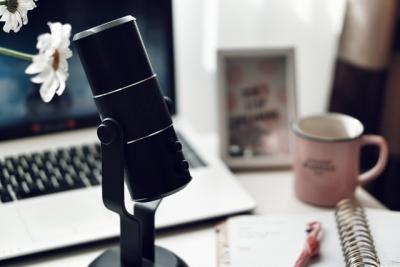How to make a great screencast application for our Fellowship Programme
Posted on 21 September 2021
How to make a great screencast application for our Fellowship Programme
 Photo by Vika Strawberrika on Unsplash
Photo by Vika Strawberrika on UnsplashApplications to the Software Sustainability Institute’s Fellowship Programme 2022 are open and the deadline to apply is 31 October 2021. The main application is a voiceover of a slide presentation screencast and reviewers will base the bulk of their decision on it during shortlisting.
Reviewers will be looking for ambitious but realistic and achievable plans that can help shape the landscape of research software and for good communication skills. So, how can you make the best impression? Here are some tips.
Tip #1 - Outline your plan
During shortlisting, you will be assessed based on your plans for the Fellowship (50%), ambassadorship (25%), and the style and content of your presentation (25%). We therefore recommend spending most of the time describing your plans for the Fellowship - specifically how will the Fellowship help you achieve your goals?
A suggested format for your screencast is:
- Who you are professionally (1 minute suggested)
- What you do (1 minute suggested)
- Your plans for the Fellowship (4 minutes suggested)
You may decide to spend more time on any section but your video application must be six minutes or less in total.
When presenting about who you are professionally, keep in mind that the reviewers may not be from your research domain. We have librarians, software developers, mathematicians, biologists, physicists, criminologists and many other domains represented by our reviewers, and some terms that might be familiar to a first-year PhD student in your field may be completely new to your reviewer so we recommend avoiding jargon. When presenting about what you do, try to turn it into a narrative that connects to your plans for the Fellowship. How do you advocate for better research practice in your domain?
With regards to your plans for the Fellowship, the Institute is very interested in supporting work that builds on previous efforts in a strategic area and/or helps nurture and grow communities of practice. Examples of this are Coding Club and Open Life Science. However, we also support novel work and new areas, such as Mental Health in Research Software Engineering.
It is not only about having the right plan. Plans should include details around how the Fellowship will be leveraged to achieve your goals, such as specificity around activities, costs, and target domain, community or audience. Reviewers will pay attention to any experience you have on delivering plans. For example, if you plan to organise a Carpentries-style workshop as part of your Fellowship, you will probably have experience organising training sessions or workshops, or an idea on how you plan to acquire the skills needed for this such as through Instructor Training. If your plan is the first of its kind, reviewers will be interested in seeing that you have a clear vision for output and outcomes, such as a series of blog posts or a new resource. But don’t worry, we will take your career stage into consideration when assessing your plans and previous experience.
Tip #2 - Audio
It can be difficult for reviewers to understand you if the quality of the audio on your recording is not clear. You do not need to use a studio microphone for your screencast, but following some good practices will help you save time and have a great recording to submit.
First, find a quiet room where you will not be disturbed and switch off all notifications - you do not want to be interrupted in the middle of your recording. Conduct sound tests before doing the full recording, and try different microphones as they can vary greatly in quality. We advise applicants to use the microphone from a USB headset as the audio capture is usually good and some have noise cancelling capabilities.
If you have finished your full recording and think that the audio has too much background noise or your voice isn't loud enough, you can use software such as Audacity to reduce the background noise and make your voice louder and clearer.
You can read our Top tips for online presentations and our Guide on Recording Screencasts, Online Training and Events and Live Streaming for more advice on testing and editing audio and video recordings.
Tip #3 - Slides
Think carefully about having too many slides in your presentation. The key to choosing the number of slides is to avoid a situation where moving to the next slide would not give reviewers enough time to read the content. Stopping the video or rewinding it a few seconds on each slide is something that reviewers will not have time to do.
Final Words
We hope that these tips help you to prepare your screencast application for the Fellowship Programme 2022. For tips on using Open Broadcaster Software Studio or Zoom to do your screencast, visit our Application Video Guide. Some of the 2021 Fellows have also kindly shared their screencasts in this YouTube playlist to inspire you to apply!
If you have questions about the Programme, please contact Rachael Ainsworth, Institute Community Manager at fellows-management@software.ac.uk.
This blog post is an updated version of the original post How to make a great screencast application for the Fellowship Programme 2019 by Raniere Silva.
